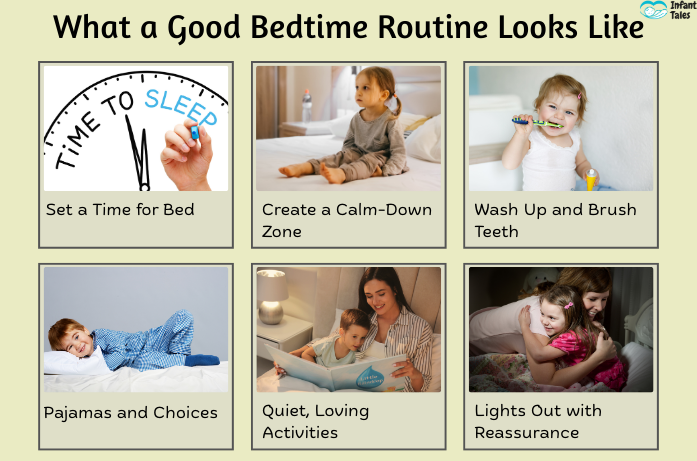By a caring mom at Infant Tales
For the Toddler Bedtime Routines parents out there, we know all about the bedtime struggle. Just when your little one is yawning, rubbing their eyes, and really tired, suddenly they’re bouncing off the walls asking for “one-more-story” or need water for the fifth time! Ringing a bell?
Bedtime can be one of the most challenging tasks for parents to manage, but it doesn’t have to be a nightly battle. The key is to establish a consistent toddler sleep schedule and loving bedtime routine. It doesn’t have to be overly strict; rather, it’s about creating small habits that gradually soothe your child and let them know it’s time to rest.
Let’s discuss why bedtime routines are so important, how to create one that fits your family, and also what you do when trials arise along the way.
Why Toddlers Need Bedtime Routines
Toddlers want independence; they also hunger for security. Routines offer a little of both. Here’s why bedtime routines work so well:
- This tells the body that it’s time to sleep. The brain starts releasing melatonin, a sleep hormone, when the body feels calm and certain.
- Kids feel safe. The only way to help them feel safe is knowing what is going to happen next because sometimes their world may feel unpredictable.
- They reduce bedtime tantrums in children at bedtime. Children who follow a regular routine don’t avoid bedtime because they know what’s expected of them.
- They promote growth. Studies from the National Library of medicine state that kids with regular bedtime routines can often do better emotional control, better concentration, and even fine brain development.
Simply put, bedtime routines are about more than sleep; they’re about emotional security and healthy growth, and helping parents build confidence with toddler bedtime Routines tips that work.

What a Good Bedtime Routine Looks Like
Every family has its rhythm, but the most effective bedtime routines usually share a few key components:
1. Set a Time for Bed
Toddlers can be expected to have about 11–14 hours of sleep every day, including naps. With a fixed time for bed, it helps their body clock to adjust and make it easy to fall asleep. The Centers for Disease Control and Prevention (CDC) also recommends keeping the bedtime unchanged during weekends, because changing it often confuses your toddler’s native rhythm and creates a problem during the mornings.
2. Create a Calm-Down Zone
Generally, half an hour before bedtime is a good time to calm down: dim the lights, turn off loud music or any other TV, and encourage quiet activities like puzzles or coloring. Try to avoid excessive screen time during this time, as the blue light emitted from devices can disrupt your child’s desire to fall asleep. These calming bedtime routine ideas set the right mood for sleep and improve overall sleep hygiene.
3. Wash Up and Brush Teeth
A short bedtime routine often begins with hygiene. Baths are relaxing for children and signal the end of the day. But if your child is a little hesitant to bathe. The AAP’s Brush, Book, Bed program encourages ending each night with brushing, reading, and sleeping at the same time to improve oral health and sleep quality together. The important thing is to keep this routine; this way, the child will associate everything with sleep.
4. Pajamas and Choices
A child thrives on independence, and if they’re allowed to make a few childlike decisions, the whole process can be effortless. They might decide to bring two pajamas or a stuffed toy to bed with them. Guidance from Nationwide Children’s Hospital notes that small choices in bedtime routines build cooperation and reduce power struggles.
5. Quiet, Loving Activities
It’s the center piece of your routine-the peaceful, relaxing activity that connects you both. Reading a bedtime tale together, singing a soft lullaby, discussing the day’s favorite occurrence, or saying goodnight to toys or family members are all activities that help make the toddler feel secure and loved. These rituals not only prepare him for sleep but also strengthen the parent-child relationship.
6. Lights Out with Reassurance
Finally, tuck your child into bed with a kiss, a hug, and some holiest words of comfort like “Goodnight, I love you” or “See you in the morning.” This assurance helps the toddler find the courage to settle. For children too scared in the dark, a soft night-light will add warmth without impeding on their sleep.
7. Consistent Sleep Environment
A consistent sleep environment is just as important as the bedtime routine itself. Keep your toddler’s bedroom quiet, dimly lit, and comfortably cool. Using the same sleep space every night helps signal to your child that it’s time to rest. You can also use soft white noise, gentle lullabies, or a cozy blanket to create a sense of comfort and familiarity. Avoid bright lights, loud noises, or new distractions that can make settling down harder. When your toddler’s surroundings stay the same each night, their body naturally learns when it’s time to relax and sleep.
Common Bedtime Challenges (And How to Handle Them)
Even with the best-intended bedtime plan, there will be roadblocks. Below are the more common ones parents have to deal with:
- The Bedtime Staller: Just one more story, I need water, I have to pee!? Sound familiar? Such stalling needs to be discouraged. Set clear and definite limits upfront set two stories and one glass of water to be agreed upon with kindness.
- Nighttime Fears: It’s normal to be afraid of monsters, shadows, and scary sounds while toddlers develop their imagination. Validate their feelings, reassure them, and then maybe use a night-light or a comfort object.
- Separation Anxiety: Sometimes toddlers cry when their parents leave the room. Try using the gradual retreat approach: first, keep sitting next to your child at bedtime; then gradually begin to sit farther away over several nights until your child gains the felt sense of security of sleeping alone.
- Nap Trouble: If naps are too late or too long, bedtime can become a battle. Adjust nap schedules so your child is tired enough at night.
Tips for Making Bedtime Easier
- Stay consistent: even during holidays and travel.
- Keep naps balanced: Too much daytime sleep equals bedtime struggles.
- Model calm energy: If you are stressed or rushing, the toddler will catch it there. Stay patient and gentle.
- Skip the sleep crutches. Avoid relying on bottles or constant rocking to put your baby to sleep, as this can create habits that make night waking more difficult.
- Encourage independence: Let your child fall asleep on his or her own, intervene if comfort is necessary.
Parenting experts from Zero to Three also highlight that toddlers thrive best when bedtime becomes a predictable, comforting experience.
When to Ask for Help
If your toddler regularly has trouble sleeping despite consistent routines, such as constant night wakings, loud snoring, or extreme difficulty calming down, its a good idea to check in with your pediatrician. Sometimes, underlying health issues like allergies or sleep apnea may play a role.
Frequently Asked Questions
1. What age should I start a bedtime routine?
They can start at infancy, but toddlers between the ages of 12 – 36 months benefit best from structured routines.
2. How long should a bedtime routine take?
Usually, twenty minutes to forty minutes will do. A longer routine makes kids restless, and a shorter one may not make them feel settled.
3. Should I let my toddler?
Every family chooses differently. Gentle reassurance usually works best with toddlers who want security; this means checking in with them but not really giving in to their stalling.
4. What if my kid wakes up in the middle of the night?
The response needs to be calm and consistent, keep talking to a minimum, keep the lights dimmed, offer a gentle reassurance, but never turn this into a playtime.
Final Thoughts
The bedtime routine really does not have to be a nightly battle of wills with the toddler. Consider it a rhythm: a predictable loving flow of steps that carry the child gently from active play time into the land of dream. Sure, there will be nights when things just do not go as planned, for one thing-a toddler! But in time, these little rituals instill with that child a feeling of security, interconnection, and good sleep habits for a lifetime to look back on.
In the end, beyond just getting a toddler to sleep, it is all about helping them feel secure, loved, and ready for tomorrow fresh.
Disclaimer: This guide is only for informational purposes. It should never replace medical advice. If you feel suspicious or uneasy about your child’s sleeping habits or his/her general state of being, you should discuss it with a pediatrician.
Parenting is not about becoming perfect; it’s about being consistent, showing love, and showing patience. If you feel that your bedtime is difficult, remember: you are not alone, and it does get easier.
For more parenting tips, check out other helpful guides on Infant Tales.



